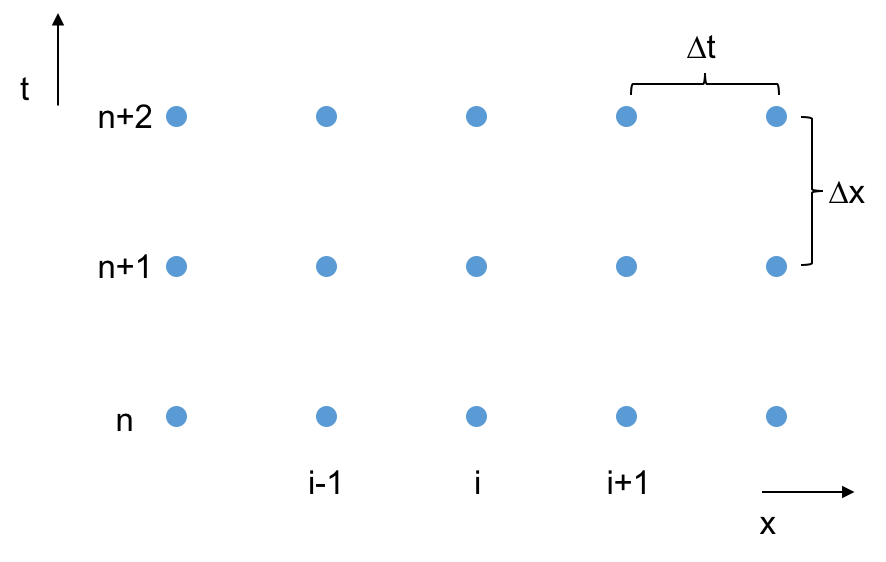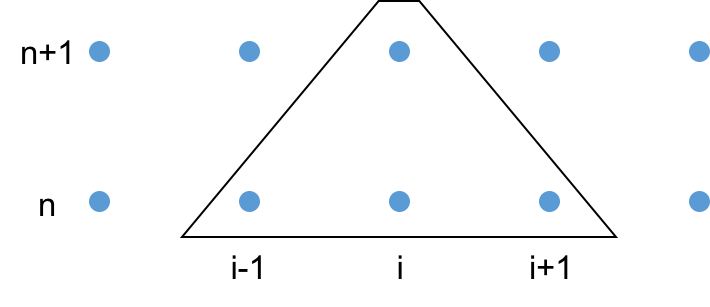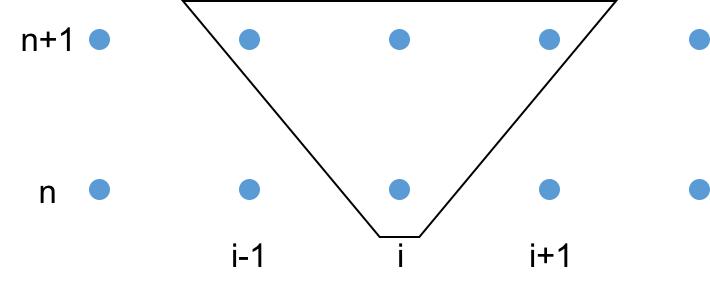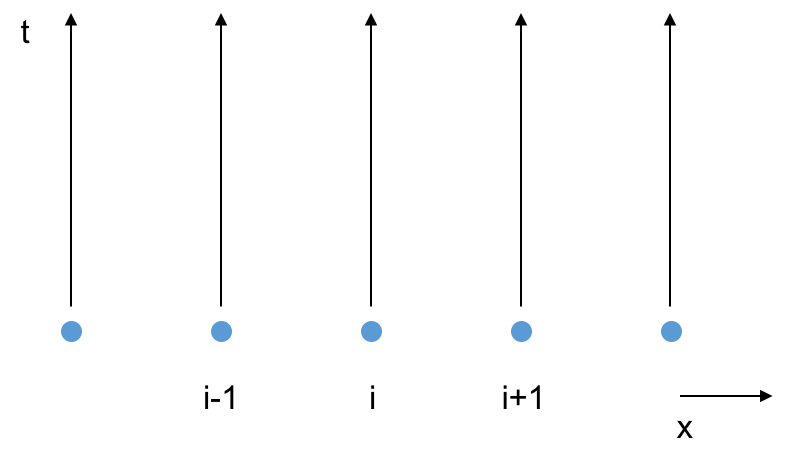Parabolic PDEs¶
Outline¶
- FTCS: Forward time centered space
- BTCS: Backward time centered space
- CN: Crank Nicolson
- MOL: Method of lines
Setup¶
- The PDE we'll consider here is the unsteady diffusion equation. $$\frac{\partial f}{\partial t} = \alpha\frac{\partial^2f}{\partial x^2}.$$
- The grid:

FTCS¶
- Forward difference approximation for the time derivative.
- Central difference approximation for the space derivative.
- Evaluate the spatial term at the old time.
- This is like Explicit Euler at point $n$ in time.
- Explicit
- First order in time
- Second order in space
$$\frac{\partial f}{\partial t} = \alpha\frac{\partial^2f}{\partial x^2},$$
$$\frac{f_i^{n+1}-f_i^n}{\Delta t} = \alpha\frac{f_{i-1}^n - 2f_i^n + f_{i+1}^n}{\Delta x^2},$$
$$f_i^{n+1}=f_i^n + \frac{\alpha\Delta t}{\Delta x^2}(f_{i-1}^n - 2f_i^n + f_{i+1}^n).$$
$$f_i^{n+1}=f_i^n + d\cdot(f_{i-1}^n - 2f_i^n + f_{i+1}^n),$$ $$d = \frac{\alpha\Delta t}{\Delta x^2}.$$Approach¶
- Start with the initial condition
- Advance each grid point in time based on itself and its neighbors at the previous time.
- BC's are as for boundary value problems.
Stencil¶

BTCS¶
- Backward difference approximation for the time derivative.
- Central difference approximation for the space derivative.
- Evaluate the spatial term at the new time.
- This is like Implicit Euler at point $n+1$ in time.
- Implicit
- First order in time
- Second order in space
$$\frac{\partial f}{\partial t} = \alpha\frac{\partial^2f}{\partial x^2},$$
$$\frac{f_i^{n+1}-f_i^n}{\Delta t} = \alpha\frac{f_{i-1}^{n+1} - 2f_i^{n+1} + f_{i+1}^{n+1}}{\Delta x^2},$$
$$f_{i-1}^{n+1} - \left(2+\frac{\Delta x^2}{\alpha\Delta t}\right)f_i^{n+1} + f_{i+1}^{n+1} = -\frac{\Delta x^2}{\alpha\Delta t}f_i^n.$$
$$f_{i-1}^{n+1} - \left(2+\frac{1}{d}\right)f_i^{n+1} + f_{i+1}^{n+1} = -\frac{1}{d}f_i^n.$$
Approach¶
- Start with the initial condition.
- Advance in time by solving a coupled tridiagonal system of equations at each timestep.
- BC's are as for boundary value problems.
Stencil¶

Crank Nicolson (CN)¶
- Do 50/50 FTCS and BTCS
- This is like the Implicit Trapazoid Method for initial value problems.
- This results in a linear tridiagonal system of equations at each timestep, as for the BTCS method, but with slightly different coefficients and a different $b$ vector (right hand side).
$$\frac{\partial f}{\partial t} = \alpha\frac{\partial^2f}{\partial x^2},$$
$$\frac{f_i^{n+1}-f_i^n}{\Delta t} = \frac{\alpha}{\Delta x^2}\frac{(f_{i-1}^n - 2f_i^n + f_{i+1}^n)+(f_{i-1}^{n+1} - 2f_i^{n+1} + f_{i+1}^{n+1})}{2},$$
$$\left(\frac{d}{2}\right)f_{i-1}^{n+1} -(d+1)f_i^{n+1} + \left(\frac{d}{2}\right)f_{i+1}^{n+1}= -\left(\frac{d}{2}\right)f_{i-1}^n +(d-1)f_i^n - \left(\frac{d}{2}\right)f_{i+1}^n,$$
$$f_{i-1}^{n+1} - 2\left(1+\frac{1}{d}\right)f_i^{n+1} + f_{i+1}^{n+1} = -f_{i-1}^n + 2\left(1-\frac{1}{d}\right)f_i^n - f_{i+1}^n.$$
- Implicit
- Second order in time
- Second order in space
Approach¶
- Start with the initial condition.
- Advance in time by solving a coupled tridiagonal system of equations at each timestep.
- BC's are as for boundary value problems.
Stencil¶

Derivation¶
This method can be derived by writing two Taylor series about a fictional grid point at $(n+\frac{1}{2},\, i)$, evaluated at point $n$, and point $n+1$.
$$ f_i^n = f_i^{n+1/2} - \frac{\Delta t}{2}\left.\frac{\partial f}{\partial t}\right|^{n+1/2}_i + \frac{\Delta t^2}{4}\left.\frac{\partial^2f}{\partial t^2}\right|_i^{n+1/2} + \mathcal{O}(\Delta t^3),$$
$$ f_i^{n+1} = f_i^{n+1/2} + \frac{\Delta t}{2}\left.\frac{\partial f}{\partial t}\right|^{n+1/2}_i + \frac{\Delta t^2}{4}\left.\frac{\partial^2f}{\partial t^2}\right|_i^{n+1/2} + \mathcal{O}(\Delta t^3),$$
Subtract the first equation from the second: $$ f_i^{n+1} - f_i^n = \Delta t\left.\frac{\partial f}{\partial t}\right|_i^{n+1/2} + \mathcal{O}(\Delta t^3).$$
Now, we take $$\left.\frac{\partial f}{\partial t}\right|_i^{n+1/2} = \frac{1}{2}\left(\left.\frac{\partial f}{\partial t}\right|_i^n + \left.\frac{\partial f}{\partial t}\right|_i^{n+1}\right) = \frac{1}{2}\frac{\alpha}{\Delta x^2}[(f_{i-1}^n - 2f_i^n + f_{i+1}^n)+(f_{i-1}^{n+1} - 2f_i^{n+1} + f_{i+1}^{n+1})].$$
Inserting gives $$f_i^{n+1} - f_i^n = \frac{\Delta t}{2}\frac{\alpha}{\Delta x^2}[(f_{i-1}^n - 2f_i^n + f_{i+1}^n)+(f_{i-1}^{n+1} - 2f_i^{n+1} + f_{i+1}^{n+1})],$$
which rearranges to the final result.
Generalization¶
- The CN method can be generalized to an $\omega$ method.
- Instead of taking a 50/50 split of the RHS at old and new times, we can take some other combination:
- For $\omega=0$ we have FTCS.
- For $\omega=1$ we have BTCS.
- For $\omega=1/2$ we have CN.
Method of Lines (MOL)¶
- Discretize just the spatial domain, but not the time domain.
- This is now a coupled system of ODEs.
- We have one ODE for each grid point $i$.
- The is formulated as continuous in time, and discrete in space.

- Normally, the ODE solver will also discretize in time, but this is done internally.
- (we still end up with a discrete solution in time and space).
- time domain might not have uniform grid spacing, as per the ODE solver chosen.